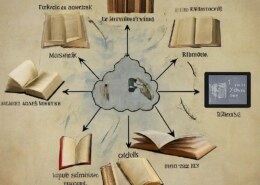The advent of digital technology and e-books has profoundly transformed traditional print literature and the reading experience. Here’s an overview of these changes: 1. Accessibility and Distribution Increased Reach: Digital technology has significantly expanded the reach of literature. E-books andRead more
The advent of digital technology and e-books has profoundly transformed traditional print literature and the reading experience. Here’s an overview of these changes:
1. Accessibility and Distribution
- Increased Reach: Digital technology has significantly expanded the reach of literature. E-books and online publications are accessible globally, allowing authors and publishers to reach a wider audience without the geographical constraints of print.
- Instant Access: Readers can instantly access and purchase books from digital platforms, reducing the time and effort needed to acquire new literature. This immediacy contrasts with the often time-consuming process of ordering and waiting for print books.
2. Changing Reading Habits
- Convenience: E-books provide the convenience of carrying multiple books in a single device, such as a tablet or e-reader. This portability has altered reading habits, enabling readers to access their libraries anytime, anywhere.
- Multimedia Integration: Digital platforms often include interactive features such as hyperlinks, multimedia content (videos, audio), and annotations, enhancing the reading experience and providing supplementary material that print books cannot.
3. Economic and Environmental Implications
- Cost Efficiency: E-books often cost less to produce and purchase compared to print books. The elimination of printing, shipping, and storage costs benefits both publishers and consumers.
- Environmental Impact: Digital books reduce the need for paper and physical resources, which can contribute to a decrease in the environmental impact associated with print publishing.
4. Preservation and Innovation
- Archiving and Preservation: Digital technology aids in the preservation of literary works by providing a format that can be easily stored and backed up, ensuring that literature remains accessible over time.
- New Formats and Genres: The digital age has introduced new literary forms such as interactive fiction, serialized content, and self-publishing platforms, allowing for greater innovation and experimentation in literature.
5. Challenges and Considerations
- Digital Divide: Access to digital literature requires technology and internet connectivity, which may exclude certain populations and contribute to the digital divide.
- Sensory Experience: Some readers and critics argue that digital reading lacks the tactile pleasure and aesthetic experience associated with traditional print books, including the feel of paper and the physical presence of a book.


Technology significantly enhances education by making learning more accessible, interactive, and personalized. Online resources, such as educational videos, interactive simulations, and digital textbooks, provide students with a wealth of information that can be accessed anytime and anywhere, breakiRead more
Technology significantly enhances education by making learning more accessible, interactive, and personalized. Online resources, such as educational videos, interactive simulations, and digital textbooks, provide students with a wealth of information that can be accessed anytime and anywhere, breaking down geographical and socio-economic barriers.
Learning management systems (LMS) facilitate organization and communication, allowing teachers to assign tasks, track progress, and provide feedback efficiently. Tools like virtual classrooms and video conferencing enable remote learning, offering flexibility and continuity even when in-person attendance isn’t possible.
Adaptive learning technologies use data analytics to tailor educational content to individual student needs, helping to address varying learning paces and styles. Gamification and interactive applications engage students through immersive experiences, making learning more enjoyable and effective.
Moreover, technology fosters collaboration through digital platforms where students can work together on projects, share knowledge, and solve problems collectively. Augmented reality (AR) and virtual reality (VR) provide experiential learning opportunities, allowing students to explore complex concepts in an interactive and tangible way.
Overall, technology enriches education by enhancing accessibility, engagement, and personalization, preparing students for a rapidly evolving world.
See less